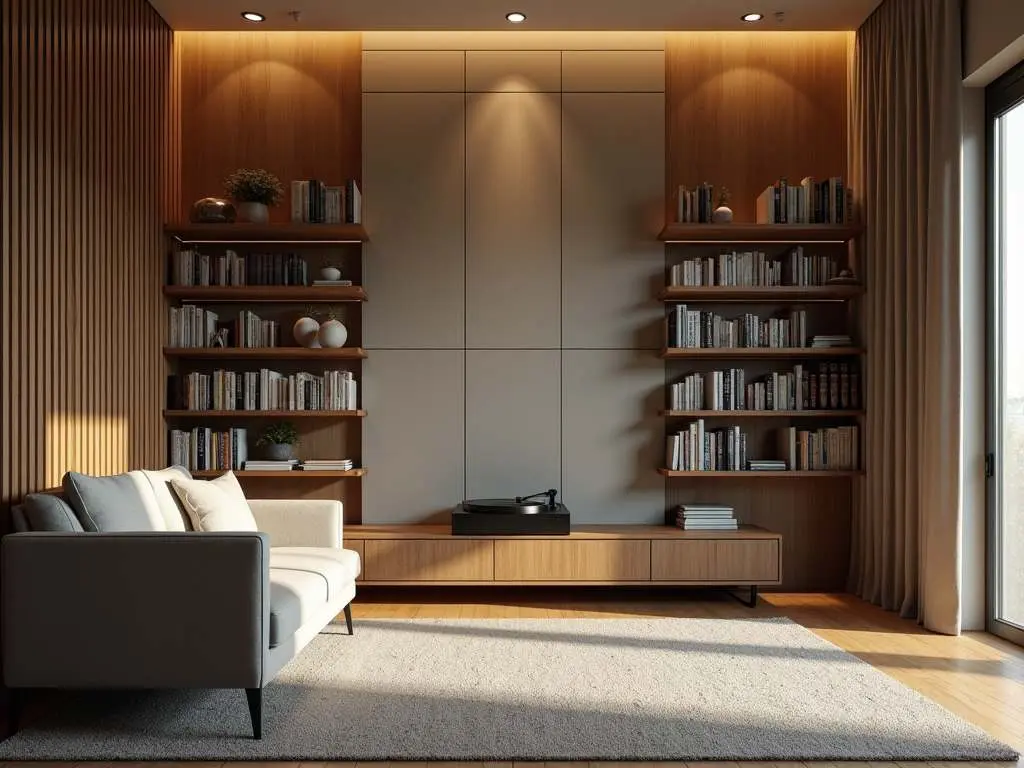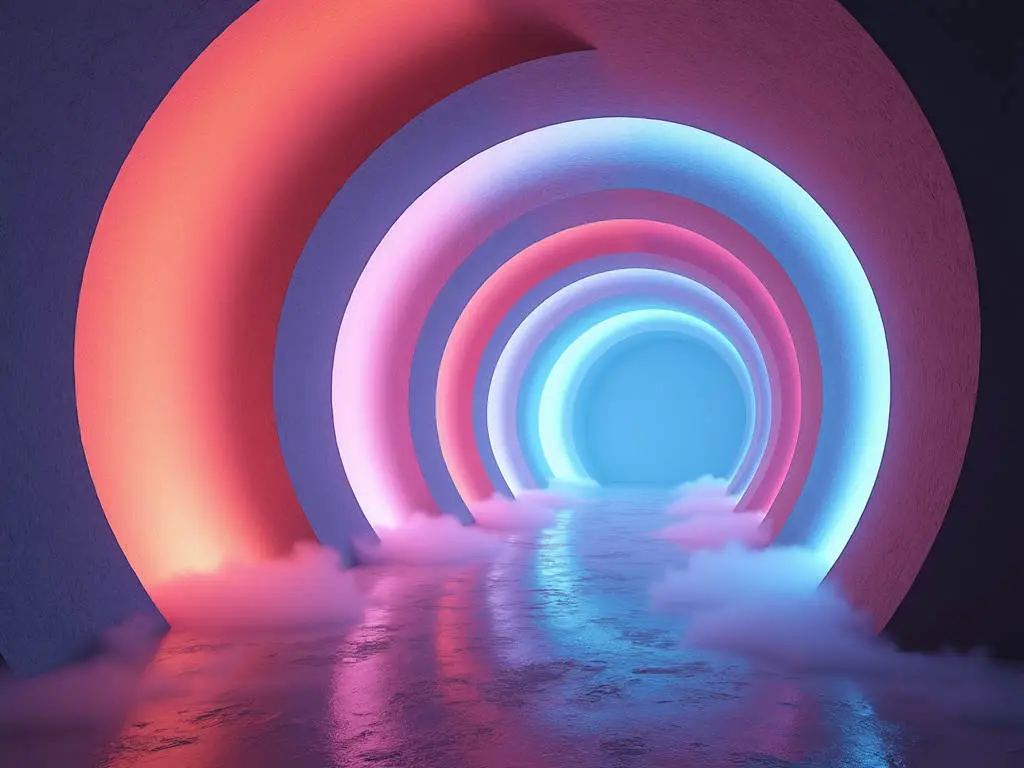My expertise in environmental design has shown that managing sensory transitions is key to harmony. At Curvspace, we fine-tune light, sound, and temperature to create inviting thresholds. This article explains how subtle sensory adjustments transform transitional spaces into immersive experiences.
Jump to:
The Art of Sensory Transition
Environmental design is more than just aesthetics; it’s about crafting experiences. A key element often overlooked is the sensory bridge: the deliberate manipulation of light and sound, and temperature to ease transitions between spaces. At Curvspace, we believe that these sensory adjustments can transform mundane areas into immersive experiences, enhancing the overall quality and feel of any environment.
Understanding Sensory Design
Sensory design is a holistic approach that engages all five senses to transform a space into a multifaceted area where all senses play their role. It’s about creating environments that resonate deeply with occupants, leaving lasting impressions. This involves using tactile materials, ambient lighting, and curated soundscapes to evoke emotional responses and enhance well-being.
The Importance of Transitional Spaces
Transitional spaces, like antechambers and corridors, serve as more than just passageways. They offer opportunities to set a tone, evoke emotions, and craft experiences. By reimagining these spaces with multi-sensory elements, designers can transform them into vibrant sensory gateways that prepare individuals for the spaces beyond.
The Role of Light
Light is a fundamental element of sensory design, influencing mood, perception, and overall ambiance. Designers use innovative lighting solutions, textures, and color palettes to dynamically alter the mood of a space.
- Natural Light: Maximizing daylight reduces the need for artificial lighting and enhances visual appeal, improving mood and productivity.
- Layered Lighting: Combining task, ambient, and accent lighting creates depth and dimension, providing flexibility to adjust the mood.
- Color Temperature: Adjustable color temperatures enable the creation of varying atmospheres, with warm tones promoting relaxation and cooler tones enhancing focus.
The Symphony of Sound

Sound is another crucial sensory element, capable of influencing mood and perception. Integrating acoustic materials and sound installations can harmonize with architectural features, creating calming or stimulating atmospheres.
- Soothing Sounds: Gentle water sounds or ambient music can create a calming atmosphere, preparing visitors for the experience ahead.
- Acoustic Comfort: Elements like rugs and curtains can control acoustics, reducing noise and improving comfort.
- Soundscapes: Curated auditory experiences can significantly influence mood and perception.
Temperature’s Subtle Influence
Temperature, often an unconscious factor, profoundly impacts comfort and well-being. Thoughtful temperature control can create welcoming and relaxing spaces.
- Thermal Comfort: Maintaining consistent and comfortable temperatures enhances the overall experience of a space.
- Natural Ventilation: Integrating natural ventilation improves air quality and creates a more pleasant environment.
- Adaptive Systems: Smart systems can adjust temperature based on occupancy and preferences, creating personalized experiences.
Case Studies: Sensory Bridges in Action
Airport Sensory Rooms
Airports are stressful environments, and sensory rooms provide a safe space for passengers to decompress and self-regulate. These rooms use carefully selected finishes, lighting, and furniture to calm and engage senses, supporting neurodivergent travelers and others seeking respite.
Reimagined Antechambers

Designers are transforming antechambers into multi-sensory spaces that engage sight, sound, touch, and even smell. These spaces use chromatic illusions, curated soundscapes, and tactile materials to create immersive experiences.
Unexpected combinations of disparate ideas
Consider blending natural elements like a living wall with technological integrations such as interactive light displays that respond to touch. This unexpected combination merges the calming effect of nature with the engaging aspect of technology, creating a transitional space that is both soothing and stimulating.
Open-ended questions that encourage divergent thinking
How can we design transitional spaces that not only serve as pathways but also as destinations in themselves? What if corridors became interactive art galleries or mini-gardens, offering moments of pause and reflection?
The Human-Centric Approach
Ultimately, the focus on sensory bridges underscores a broader shift towards human-centric architecture. By thoughtfully engaging all senses, architects create environments that resonate deeply with occupants, fostering emotional connections and enhancing overall experiences.
Challenging common industry assumptions with fresh insights
One common assumption is that transitional spaces should be neutral and unobtrusive. However, by challenging this assumption, we can transform these spaces into dynamic, engaging environments that enhance the overall architectural experience.
People Also Ask
How does sensory design contribute to sustainability?
Sensory design intersects with sustainability by considering both environmental impact and sensory enrichment. Sustainable design ensures that spaces meet aesthetic and functional needs while contributing positively to environmental and social ecosystems.
What role does biophilic design play in creating sensory bridges?
Biophilic design integrates natural elements to foster a connection with nature and enhance human well-being. Integrating nature into built environments significantly improves mental health, reduces stress, and boosts productivity.
How can technology enhance sensory experiences in transitional spaces?
Advances in augmented reality (AR) and virtual reality (VR) offer architects unprecedented tools to visualize and refine sensory experiences. Smart home technology and IoT devices can adapt sensory experiences to individual preferences and needs, creating personalized and memorable experiences.
Conclusion

By fine-tuning light, sound, and temperature, we can transform transitional spaces into immersive experiences that enhance well-being and create lasting impressions. Contact Curvspace today to discover how our expertise in environmental design can elevate your space.
References
- ালী, এ. এ., & Allee, P. A. (2000). গণতন্ত্রের সংকট (M. Rashid, Trans.). University Press Limited.
- Brown, T. (2005). Design thinking. Harvard Business Review, 86(4), 84-94.
- Herzog, T. R., Maguire, C. P., & Nebel, M. B. (2003). Assessing the restorative components of environments. Journal of Environmental Psychology, 23(2), 159-170.
- Kim, J., & Choi, Y. (2019). The effects of sensory experience on brand attitude and purchase intention in the context of fashion retail. Journal of Business Research, 97, 339-347.
- Ryan, C. O., Browning, W. D., Clancy, J. O., Andrews, S. L., & Kallianpurkar, N. B. (2014). Biophilic design patterns: Emerging nature-based parameters for health and well-being in the built environment. International Journal of Architectural Research: ArchNet-IJAR, 8(2), 62-76.
Disclosure
Our content is reader-supported. This means if you click on some of our links, then we may earn a commission. Commissions do not affect our editor’s opinions or evaluations. Learn more about our editorial process.

About the Editorial Staff
The Curvspace editorial team comprises a diverse group of experts on intermediate and threshold spaces in homes and workplaces. Architects and interior designers, civil engineers and artists, environmental and behavioral psychologists, sociologists and anthropologists. All collaborate to create helpful content, that explores the full potential of these often-overlooked areas to enhance our daily lives.


